The medical wax market is likely to expand from USD 193.5 million in 2025 to USD 336.8 million in 2035, reflecting a CAGR of 5.7%. A peak-to-trough analysis highlights adoption cycles and demand fluctuations across dental, pharmaceutical, and medical device applications. The market does not follow erratic swings but moves in phases of rapid growth and temporary stabilization. Demand is supported by consistent usage in formulations, casting, coatings, and research activities that rely on precision and high purity materials.
Between 2025 and 2030, the market is expected to record its first peak. Growth in dental applications such as impressions, casting models, and prosthetics serves as the main driver. Pharmaceutical formulations adopt waxes as controlled release agents and coating excipients, adding volume demand. Medical research relies on high purity waxes for tissue embedding and sample preparation. Technological improvements in biocompatible wax grades and innovations in customized formulations enhance adoption during this phase. Producers invest in process improvements to deliver uniformity, higher melting stability, and controlled expansion coefficients, all of which are critical in dental and pharmaceutical use. The phase establishes a strong foundation for overall market momentum.
A relative trough is projected between 2030 and 2032. Adoption in mature applications slows as replacement cycles extend and demand reaches temporary saturation. Dental and pharmaceutical segments move into steady procurement patterns. Value growth during this period is moderate, reflecting stabilization rather than decline. Producers use this phase to diversify into new wax grades and strengthen supply chains. Focus shifts to efficiency, cost control, and incremental improvements in product quality. The trough highlights how a mature segment can absorb innovation at a slower pace while sustaining base demand.
From 2032 to 2035, the market is likely to regain acceleration. Expansion in emerging regions such as Asia Pacific, Latin America, and Middle East Africa drives demand through investments in healthcare infrastructure. Personalized medical devices require advanced wax formulations with higher precision and compatibility. Specialty grades with enhanced biocompatibility and thermal stability expand usage in new applications. Adoption of waxes for high precision coatings in implants and diagnostic devices accelerates recovery. Producers that diversify into advanced formulations and invest in R&D capture stronger growth during this phase. The peak-to-trough cycle in the medical wax market demonstrates predictable adoption patterns. Early acceleration comes from established segments, followed by short stabilization periods, and renewed growth driven by regional expansion and innovation.
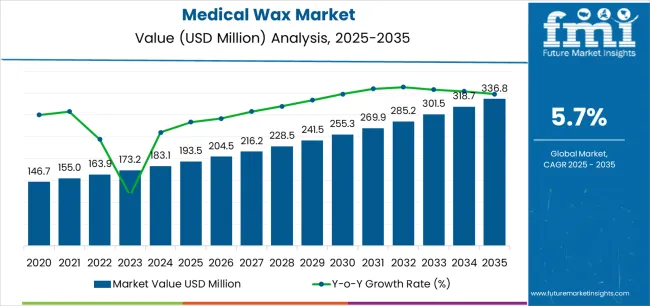
| Period | Primary Revenue Buckets | Share | Notes |
|---|---|---|---|
| Today | Paraffin wax products (therapeutic, wound care) | 42% | Traditional applications, physical therapy |
| Beeswax formulations | 28% | Natural formulations, specialty applications | |
| Microcrystalline wax solutions | 20% | Industrial medical applications | |
| Blended wax products | 10% | Custom formulations, niche applications | |
| Future (3-5 yrs) | Advanced paraffin systems | 38-40% | Temperature-controlled, smart formulations |
| Therapeutic monitoring & analytics | 18-22% | Real-time therapy tracking, patient outcomes | |
| Specialized wound care waxes | 15-18% | Antimicrobial properties, healing enhancement | |
| Custom blended formulations | 12-15% | Patient-specific, condition-targeted | |
| Digital therapy integration | 8-12% | Connected devices, therapy protocols | |
| Research & development services | 5-8% | Clinical trials, regulatory support |
The market demonstrates strong fundamentals with paraffin wax systems capturing a dominant share through advanced therapeutic capabilities and medical application optimization. Physical therapy applications drive primary demand, supported by increasing rehabilitation requirements and healthcare facility capacity expansion.
Geographic expansion remains concentrated in developed markets with established healthcare infrastructure, while emerging economies show accelerating adoption rates driven by healthcare modernization initiatives and rising quality standards.
At-a-Glance Metrics
| Metric | Value |
|---|---|
| Market Value (2025) | USD 193.5 million |
| Market Forecast (2035) | USD 336.8 million |
| Growth Rate | 5.7% CAGR |
| Leading Technology | Paraffin Wax Systems |
| Primary Application | Physical Therapy Segment |
Primary Classification: The market segments by wax type into paraffin, beeswax, microcrystalline, and blended wax formulations, representing the evolution from basic therapeutic materials to sophisticated medical solutions for comprehensive healthcare optimization.
Secondary Classification: Application segmentation divides the market into physical therapy, wound care, hot compress therapy, and surgical applications, reflecting distinct requirements for therapeutic effectiveness, safety standards, and clinical outcomes.
Tertiary Classification: End-use segmentation covers hospitals, rehabilitation centers, home healthcare, physiotherapy clinics, and research institutions, while distribution channels span direct sales, medical distributors, and online platforms.
Regional Classification: Geographic distribution covers North America, Latin America, Western Europe, Eastern Europe, East Asia, South Asia Pacific, and Middle East & Africa, with developed markets leading adoption while emerging economies show accelerating growth patterns driven by healthcare infrastructure expansion programs.
The segmentation structure reveals technology progression from standard wax materials toward sophisticated therapeutic systems with enhanced safety and efficacy capabilities, while application diversity spans from hospital facilities to home healthcare operations requiring precise therapeutic solutions.
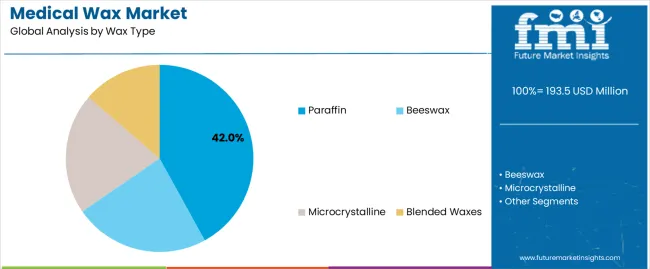
Market Position: Paraffin Wax systems command the leading position in the medical wax market with 42% market share through advanced therapeutic features, including superior heat retention, safety characteristics, and medical application optimization that enable healthcare facilities to achieve optimal therapeutic outcomes across diverse medical and rehabilitation environments.
Value Drivers: The segment benefits from healthcare facility preference for reliable therapeutic systems that provide consistent temperature performance, reduced treatment time, and operational efficiency optimization without requiring significant infrastructure modifications. Advanced formulation features enable automated temperature control systems, safety monitoring, and integration with existing medical equipment, where therapeutic performance and patient safety represent critical facility requirements.
Competitive Advantages: Paraffin Wax systems differentiate through proven therapeutic reliability, consistent heating characteristics, and integration with automated healthcare systems that enhance facility effectiveness while maintaining optimal safety standards suitable for diverse medical and therapeutic applications.
Key market characteristics:
Beeswax systems maintain a 28% market position in the medical wax market due to their natural properties and biocompatibility advantages. These formulations appeal to facilities requiring organic therapeutic solutions with competitive safety profiles for specialized medical applications. Market growth is driven by natural healthcare expansion, emphasizing organic therapeutic solutions and operational effectiveness through optimized natural designs.
Microcrystalline Wax systems capture 20% market share through specialized applications in medical device manufacturing, industrial healthcare, and specialized therapeutic requirements. These facilities demand high-performance wax systems capable of handling demanding applications while providing effective therapeutic capabilities and operational reliability.
Blended Wax formulations account for 10% market share through customized therapeutic requirements in specialized medical applications, research facilities, and development operations requiring tailored formulations for specific therapeutic outcomes.
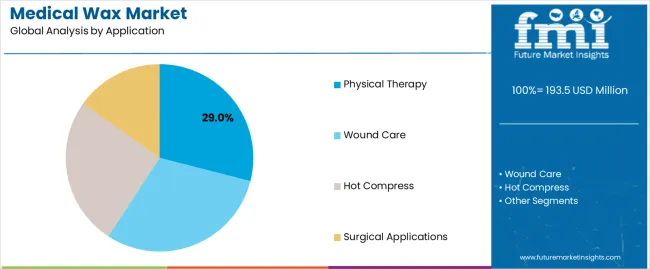
Market Context: Physical therapy applications show the highest growth in the medical wax market with a 6.8% CAGR and a 29% market share, driven by the widespread adoption of therapeutic systems and an increasing focus on rehabilitation optimization, operational cost efficiency, and patient outcome initiatives that enhance therapeutic effectiveness while maintaining safety standards.
Appeal Factors: Physical therapy operators prioritize system reliability, therapeutic consistency, and integration with existing healthcare infrastructure that enables coordinated treatment operations across multiple therapy sessions. The segment benefits from substantial healthcare investment and modernization programs that emphasize the acquisition of advanced therapeutic systems for treatment optimization and patient care applications.
Growth Drivers: Healthcare expansion programs incorporate physical therapy wax systems as standard equipment for rehabilitation operations, while aging population growth increases demand for therapeutic capabilities that comply with safety standards and minimize treatment complexity.
Market Challenges: Varying patient requirements and treatment protocol complexity may limit system standardization across different facilities or therapy scenarios.
Application dynamics include:
Wound Care applications capture 25% market share through specialized therapeutic requirements in hospitals, wound care centers, and clinical applications. These facilities demand effective therapeutic systems capable of supporting healing processes while providing safe therapeutic access and operational reliability capabilities.
Hot Compress Therapy applications account for 18% market share, including home healthcare operations, therapeutic treatments, and patient care requiring targeted heat therapy capabilities for therapeutic optimization and pain management.
Market Context: Hospitals dominate the market with 6.9% CAGR, reflecting the primary demand source for medical wax technology in therapeutic applications and patient care operations.
Business Model Advantages: Hospitals provide direct market demand for advanced therapeutic materials, driving product innovation and capacity expansion while maintaining quality control and regulatory compliance requirements.
Operational Benefits: Hospital applications include patient care, therapeutic treatments, and quality assurance that drive consistent demand for wax products while providing access to latest medical technologies.
| Category | Factor | Impact | Why It Matters |
|---|---|---|---|
| Driver | Aging population & rehabilitation demand (chronic pain, mobility issues) | ★★★★★ | Growing elderly population requires consistent therapeutic solutions with proven safety and efficacy across treatment applications. |
| Driver | Healthcare infrastructure expansion & modernization (emerging markets) | ★★★★★ | Turns advanced therapeutic systems from "optional" to "mandatory"; providers that offer clinical support and safety documentation gain competitive advantage. |
| Driver | Home healthcare growth & patient preference (convenience, cost-effectiveness) | ★★★★☆ | Home healthcare providers need safe, easy-to-use systems; demand for user-friendly and portable therapeutic solutions expanding addressable market. |
| Restraint | Regulatory compliance & safety validation costs (especially for new formulations) | ★★★★☆ | Smaller healthcare providers defer purchases; increases price sensitivity and slows advanced material adoption in cost-conscious markets. |
| Restraint | Alternative therapy competition (electric heating, ultrasound) | ★★★☆☆ | Modern therapy alternatives offer digital control and monitoring, potentially limiting traditional wax therapy adoption in tech-forward facilities. |
| Trend | Smart healthcare integration & monitoring (IoT, connected devices) | ★★★★★ | Real-time temperature monitoring, treatment tracking, and patient outcome analytics transform operations; connectivity and digital integration become core value propositions. |
| Trend | Personalized medicine & customized formulations (patient-specific needs) | ★★★★☆ | Custom wax formulations for specific conditions; specialized products and targeted therapeutic capabilities drive competition toward personalization solutions. |
The medical wax market demonstrates varied regional dynamics with Growth Leaders including China (7.7% growth rate) and India (7.1% growth rate) driving expansion through healthcare modernization initiatives and therapeutic capacity development. Steady Performers encompass Germany (6.6% growth rate), Brazil (6.0% growth rate), and developed regions, benefiting from established healthcare industries and advanced therapeutic adoption. Mature Markets feature United States (5.4% growth rate), United Kingdom (4.8% growth rate), and Japan (4.3% growth rate), where healthcare technology advancement and regulatory standardization requirements support consistent growth patterns.
Regional synthesis reveals East Asian markets leading adoption through healthcare expansion and infrastructure development, while North American countries maintain steady expansion supported by therapeutic technology advancement and clinical standardization requirements. European markets show moderate growth driven by healthcare applications and quality integration trends.
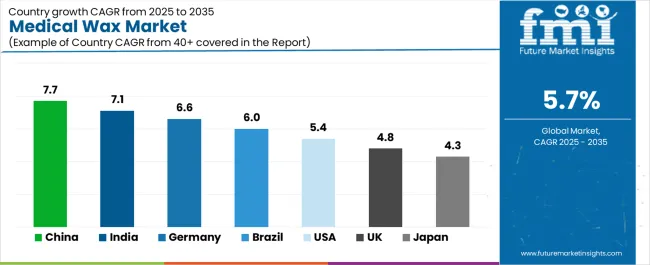
| Region/Country | 2025 to 2035 Growth | How to win | What to watch out |
|---|---|---|---|
| China | 7.7% | Focus on healthcare modernization solutions | Regulatory changes; local competition |
| India | 7.1% | Lead with cost-effective systems | Import restrictions; price sensitivity |
| Germany | 6.6% | Provide premium quality products | Over-regulation; lengthy approvals |
| Brazil | 6.0% | Offer value-oriented models | Currency fluctuations; import duties |
| United States | 5.4% | Push digital integration | FDA compliance costs; reimbursement issues |
| United Kingdom | 4.8% | Focus on NHS compatibility | Brexit impacts; budget constraints |
| Japan | 4.3% | Emphasize precision systems | Aging infrastructure; slow adoption |
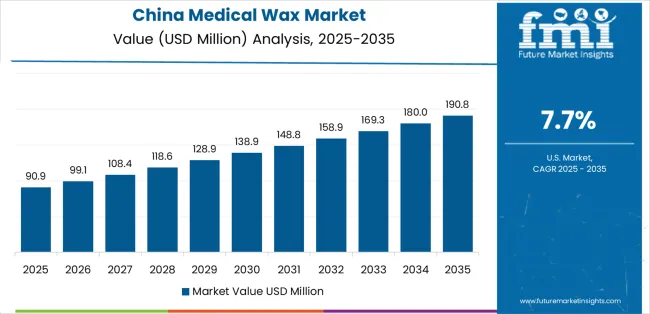
China establishes fastest market growth through aggressive healthcare modernization programs and comprehensive therapeutic capacity development, integrating advanced medical wax systems as standard components in rehabilitation facilities and hospital therapeutic installations. The country's 7.7% growth rate reflects government initiatives promoting healthcare infrastructure and domestic therapeutic capabilities that mandate the use of advanced wax systems in medical and rehabilitation facilities. Growth concentrates in major healthcare hubs, including Beijing, Shanghai, and Guangzhou, where medical technology development showcases integrated therapeutic systems that appeal to healthcare operators seeking advanced treatment optimization capabilities and patient care applications.
Chinese manufacturers are developing cost-effective wax solutions that combine domestic production advantages with advanced therapeutic features, including automated temperature control and enhanced safety capabilities. Distribution channels through medical equipment suppliers and healthcare service distributors expand market access, while government support for healthcare modernization supports adoption across diverse medical and rehabilitation segments.
Strategic Market Indicators:
In Delhi, Mumbai, and Bangalore, healthcare facilities and rehabilitation centers are implementing advanced medical wax systems as standard equipment for therapeutic optimization and patient care applications, driven by increasing government healthcare investment and infrastructure modernization programs that emphasize the importance of therapeutic capabilities. The market holds a 7.1% growth rate, supported by government healthcare initiatives and infrastructure development programs that promote advanced therapeutic systems for medical and rehabilitation facilities. Indian operators are adopting wax systems that provide consistent therapeutic performance and safety features, particularly appealing in urban regions where treatment effectiveness and patient outcomes represent critical operational requirements.
Market expansion benefits from growing healthcare capabilities and international technology partnerships that enable domestic production of advanced therapeutic systems for medical and rehabilitation applications. Technology adoption follows patterns established in medical equipment, where reliability and performance drive procurement decisions and operational deployment.
Market Intelligence Brief:
Germany's advanced healthcare technology market demonstrates sophisticated medical wax deployment with documented therapeutic effectiveness in medical applications and rehabilitation facilities through integration with existing patient care systems and healthcare infrastructure. The country leverages engineering expertise in medical technology and quality systems integration to maintain a 6.6% growth rate. Healthcare centers, including Baden-Württemberg, Bavaria, and North Rhine-Westphalia, showcase premium installations where therapeutic systems integrate with comprehensive patient care platforms and facility management systems to optimize treatment operations and therapeutic effectiveness.
German manufacturers prioritize system precision and EU compliance in therapeutic equipment development, creating demand for premium systems with advanced features, including facility monitoring integration and automated safety systems. The market benefits from established healthcare technology infrastructure and a willingness to invest in advanced therapeutic technologies that provide long-term operational benefits and compliance with international medical standards.
Market Intelligence Brief:
Brazil's market expansion benefits from diverse healthcare demand, including infrastructure modernization in São Paulo and Rio de Janeiro, medical facility upgrades, and government healthcare programs that increasingly incorporate therapeutic solutions for patient care applications. The country maintains a 6.0% growth rate, driven by rising healthcare activity and increasing recognition of therapeutic technology benefits, including precise temperature control and enhanced treatment effectiveness.
Market dynamics focus on cost-effective therapeutic solutions that balance advanced clinical performance with affordability considerations important to Brazilian healthcare operators. Growing healthcare industrialization creates continued demand for modern therapeutic systems in new facility infrastructure and medical modernization projects.
Strategic Market Considerations:
United States establishes market leadership through comprehensive healthcare programs and advanced medical infrastructure development, integrating medical wax systems across hospital and rehabilitation applications. The country's 5.4% growth rate reflects established healthcare industry relationships and mature therapeutic technology adoption that supports widespread use of precision therapeutic systems in medical and rehabilitation facilities. Growth concentrates in major healthcare centers, including California, Texas, and New York, where medical technology showcases mature therapeutic deployment that appeals to healthcare operators seeking proven therapeutic capabilities and operational efficiency applications.
American healthcare providers leverage established distribution networks and comprehensive clinical support capabilities, including validation programs and training support that create customer relationships and operational advantages. The market benefits from mature regulatory standards and healthcare requirements that mandate therapeutic system use while supporting technology advancement and operational optimization.
Market Intelligence Brief:
United Kingdom's healthcare market demonstrates integrated medical wax deployment with documented clinical effectiveness in NHS applications and private healthcare facilities through integration with existing patient care systems and medical infrastructure. The country maintains a 4.8% growth rate, supported by healthcare modernization programs and clinical effectiveness requirements that promote advanced therapeutic systems for medical applications. Healthcare facilities across England, Scotland, and Wales showcase systematic installations where therapeutic systems integrate with comprehensive patient care platforms to optimize treatment operations and clinical outcomes.
UK healthcare providers prioritize system reliability and NHS compatibility in therapeutic equipment procurement, creating demand for validated systems with proven clinical features, including patient monitoring integration and automated safety systems. The market benefits from established healthcare infrastructure and clinical validation requirements that support therapeutic technology adoption and operational effectiveness.
Market Intelligence Brief:
Japan's market growth benefits from precision healthcare demand, including advanced medical facilities in Tokyo and Osaka, healthcare technology integration, and aging population programs that increasingly incorporate therapeutic solutions for patient care applications. The country maintains a 4.3% growth rate, driven by healthcare technology advancement and increasing recognition of precision therapeutic benefits, including accurate temperature control and enhanced clinical outcomes.
Market dynamics focus on high-precision therapeutic solutions that meet Japanese quality standards and clinical effectiveness requirements important to healthcare operators. Advanced healthcare technology adoption creates continued demand for sophisticated therapeutic systems in medical facility infrastructure and clinical modernization projects.
Strategic Market Considerations:
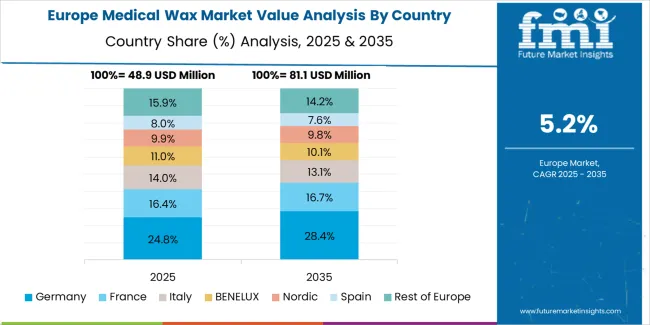
The European medical wax market is projected to grow from USD 52.8 million in 2025 to USD 89.4 million by 2035, registering a CAGR of 5.4% over the forecast period. Germany is expected to maintain its leadership position with a 38.2% market share in 2025, supported by its advanced healthcare technology infrastructure and major medical centers.
United Kingdom follows with a 24.6% share in 2025, driven by comprehensive NHS programs and healthcare technology development initiatives. France holds a 16.8% share through specialized medical applications and clinical compliance requirements. Italy commands a 11.4% share, while Spain accounts for 9.0% in 2025. The rest of Europe region is anticipated to gain momentum, expanding its collective share from 5.8% to 6.2% by 2035, attributed to increasing healthcare adoption in Nordic countries and emerging medical facilities implementing healthcare modernization programs.
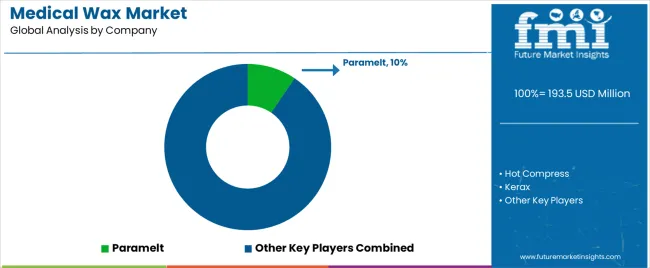
| Stakeholder | What they actually control | Typical strengths | Typical blind spots |
|---|---|---|---|
| Global platforms | Distribution reach, broad product catalogs, clinical support networks | Wide availability, proven safety, multi-region support | Product refresh cycles; customer dependency on clinical validation |
| Formulation innovators | R&D capabilities; advanced therapeutic formulations; clean safety profiles | Latest formulations first; attractive ROI on therapeutic effectiveness | Service density outside core regions; customization complexity |
| Regional specialists | Local compliance, fast delivery, nearby clinical support | "Close to site" support; pragmatic pricing; local regulations | Formulation gaps; talent retention in clinical support |
| Clinical-focused ecosystems | Safety validation, clinical training, regulatory support | Lowest clinical risk; comprehensive support | Service costs if overpromised; technology obsolescence |
| Niche specialists | Specialized applications, custom formulations, research support | Win research/development applications; flexible configurations | Scalability limitations; narrow market focus |
| Item | Value |
|---|---|
| Quantitative Units | USD 193.5 million |
| Wax Type | Paraffin, Beeswax, Microcrystalline, Blended Waxes |
| Application | Physical Therapy, Wound Care, Hot Compress, Surgical Applications |
| End Use | Hospitals, Rehabilitation Centers, Home Healthcare, Physiotherapy Clinics, Research Institutions |
| Regions Covered | North America, Latin America, Western Europe, Eastern Europe, East Asia, South Asia Pacific, Middle East & Africa |
| Countries Covered | China, India, Germany, Brazil, United States, United Kingdom, Japan, Canada, France, Australia, and 25+ additional countries |
| Key Companies Profiled | Paramelt, Hot Compress, Kerax, Universal Sutures, TELEFLEX MEDICAL, DONGKE GROUP, Jiangsu Huida Medical Instruments Co.,Ltd, Blayson Group Limited, Surgical Sutures Private Limited |
| Additional Attributes | Dollar sales by wax type and application categories, regional adoption trends across East Asia, North America, and Western Europe, competitive landscape with medical equipment manufacturers and healthcare suppliers, healthcare operator preferences for therapeutic effectiveness and safety reliability, integration with healthcare platforms and patient monitoring systems, innovations in wax formulations and therapeutic enhancement, and development of advanced therapeutic solutions with enhanced performance and medical optimization capabilities. |
The global medical wax market is estimated to be valued at USD 193.5 million in 2025.
The market size for the medical wax market is projected to reach USD 336.8 million by 2035.
The medical wax market is expected to grow at a 5.7% CAGR between 2025 and 2035.
The key product types in medical wax market are paraffin , beeswax, microcrystalline and blended waxes.
In terms of application, physical therapy segment to command 29.0% share in the medical wax market in 2025.






Our Research Products

The "Full Research Suite" delivers actionable market intel, deep dives on markets or technologies, so clients act faster, cut risk, and unlock growth.

The Leaderboard benchmarks and ranks top vendors, classifying them as Established Leaders, Leading Challengers, or Disruptors & Challengers.

Locates where complements amplify value and substitutes erode it, forecasting net impact by horizon

We deliver granular, decision-grade intel: market sizing, 5-year forecasts, pricing, adoption, usage, revenue, and operational KPIs—plus competitor tracking, regulation, and value chains—across 60 countries broadly.

Spot the shifts before they hit your P&L. We track inflection points, adoption curves, pricing moves, and ecosystem plays to show where demand is heading, why it is changing, and what to do next across high-growth markets and disruptive tech

Real-time reads of user behavior. We track shifting priorities, perceptions of today’s and next-gen services, and provider experience, then pace how fast tech moves from trial to adoption, blending buyer, consumer, and channel inputs with social signals (#WhySwitch, #UX).

Partner with our analyst team to build a custom report designed around your business priorities. From analysing market trends to assessing competitors or crafting bespoke datasets, we tailor insights to your needs.
Supplier Intelligence
Discovery & Profiling
Capacity & Footprint
Performance & Risk
Compliance & Governance
Commercial Readiness
Who Supplies Whom
Scorecards & Shortlists
Playbooks & Docs
Category Intelligence
Definition & Scope
Demand & Use Cases
Cost Drivers
Market Structure
Supply Chain Map
Trade & Policy
Operating Norms
Deliverables
Buyer Intelligence
Account Basics
Spend & Scope
Procurement Model
Vendor Requirements
Terms & Policies
Entry Strategy
Pain Points & Triggers
Outputs
Pricing Analysis
Benchmarks
Trends
Should-Cost
Indexation
Landed Cost
Commercial Terms
Deliverables
Brand Analysis
Positioning & Value Prop
Share & Presence
Customer Evidence
Go-to-Market
Digital & Reputation
Compliance & Trust
KPIs & Gaps
Outputs
Full Research Suite comprises of:
Market outlook & trends analysis
Interviews & case studies
Strategic recommendations
Vendor profiles & capabilities analysis
5-year forecasts
8 regions and 60+ country-level data splits
Market segment data splits
12 months of continuous data updates
DELIVERED AS:
PDF EXCEL ONLINE
Medical Silicone Radiopaque Vascular Ties Market Size and Share Forecast Outlook 2025 to 2035
Medical Indoor Air Purifier Market Size and Share Forecast Outlook 2025 to 2035
Medical Eye Shield Film Market Size and Share Forecast Outlook 2025 to 2035
Medical Far Infrared Therapy Device Market Size and Share Forecast Outlook 2025 to 2035
Medical Latex Protective Suit Market Size and Share Forecast Outlook 2025 to 2035
Medical Activated Carbon Dressing Market Size and Share Forecast Outlook 2025 to 2035
Medical Coated Roll Stock Market Size and Share Forecast Outlook 2025 to 2035
Medical Billing Outsourcing Market Size and Share Forecast Outlook 2025 to 2035
Medical Pressure Mapping System Market Size and Share Forecast Outlook 2025 to 2035
Medical Chairs Market Size and Share Forecast Outlook 2025 to 2035
Medical Exoskeleton Market Forecast Outlook 2025 to 2035
Medical Display Market Forecast and Outlook 2025 to 2035
Medical Spa Market Size and Share Forecast Outlook 2025 to 2035
Medical Face Shield Market Forecast and Outlook 2025 to 2035
Medical Robot Market Size and Share Forecast Outlook 2025 to 2035
Waxed Paper Market Size and Share Market Forecast and Outlook 2025 to 2035
Medical Nutrition Market Forecast and Outlook 2025 to 2035
Medical Specialty Bag Market Size and Share Forecast Outlook 2025 to 2035
Medical Plastics Market Size and Share Forecast Outlook 2025 to 2035
Medical Device Tester Market Size and Share Forecast Outlook 2025 to 2035

Thank you!
You will receive an email from our Business Development Manager. Please be sure to check your SPAM/JUNK folder too.
Chat With
MaRIA